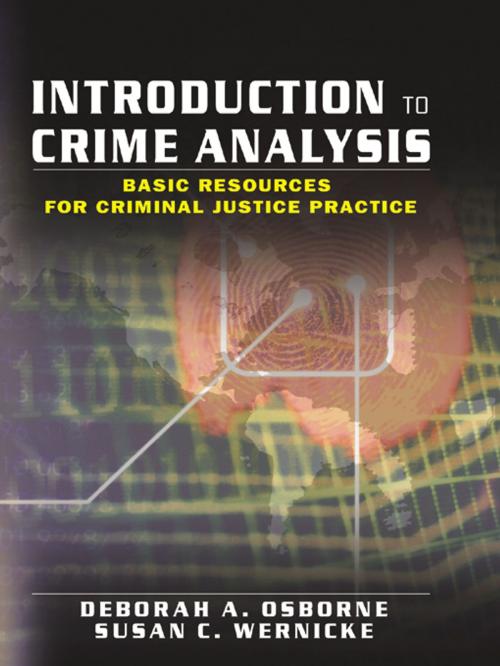Introduction to Crime Analysis
Basic Resources for Criminal Justice Practice
Nonfiction, Social & Cultural Studies, Social Science, Crimes & Criminals, Criminology, Reference & Language, Law, Political Science| Author: | Deborah Osborne, Susan Wernicke | ISBN: | 9781136614729 |
| Publisher: | Taylor and Francis | Publication: | January 11, 2013 |
| Imprint: | Routledge | Language: | English |
| Author: | Deborah Osborne, Susan Wernicke |
| ISBN: | 9781136614729 |
| Publisher: | Taylor and Francis |
| Publication: | January 11, 2013 |
| Imprint: | Routledge |
| Language: | English |
Successfully analyze crime at any level of law enforcement!
This book is a practical resource guide for the development of crime analysis in local law enforcement. The tragedy of September 11, 2001, has raised awareness on how crucial it is to analyze information and intelligence. Smaller agencies that cannot financially justify hiring a full-time analyst will find strategies and techniques to teach officers the methods of analysis. Introduction to Crime Analysis: Basic Resources for Criminal Justice Practice provides basic tools and step-by-step directions that will improve the skills and knowledge of new crime analysts.
From the editors: Military strategists have used analysis for centuries; it makes sense to know as much as possible about the enemy and about the conditions and causes of a situation if we hope to institute any kind of significant change for the better. Career criminals are the enemies of a community's well being. Now that advances in information technology give us the means and methods to fully examine and find meaningful knowledge in the vast amounts of existing information on crimes and criminals, we have an obligation to use our technological strength to protect innocent people. Systematic crime analysis as a law enforcement and public safety asset has become not only possible, but also truly necessary as a weapon in the war against crime.
Along with defining the various roles of the crime analyst, Introduction to Crime Analysis demonstrates how to:
- improve the personal skills necessary to make you a good crime analyst
- successfully work through the five stages-collection, collation, analysis, dissemination, and feedback and evaluation-of analysis
- select the appropriate crime mapping software for your agency
- evaluate the usefulness of your crime analysis products
- benefit from email discussion groups and professional associations
- create a crime analysis unit-including policies and procedures as well as marketing and funding
This clearly written resource includes case studies, figures, and appendixes that will simplify the learning process. Links to Internet pages also offer resources and information beneficial to both new and experienced crime analysts. Introduction to Crime Analysis will benefit crime analysts, police officers, intelligence analysts, community groups focused on crime prevention, criminal justice students, and police departments and sheriff’s agencies.
Successfully analyze crime at any level of law enforcement!
This book is a practical resource guide for the development of crime analysis in local law enforcement. The tragedy of September 11, 2001, has raised awareness on how crucial it is to analyze information and intelligence. Smaller agencies that cannot financially justify hiring a full-time analyst will find strategies and techniques to teach officers the methods of analysis. Introduction to Crime Analysis: Basic Resources for Criminal Justice Practice provides basic tools and step-by-step directions that will improve the skills and knowledge of new crime analysts.
From the editors: Military strategists have used analysis for centuries; it makes sense to know as much as possible about the enemy and about the conditions and causes of a situation if we hope to institute any kind of significant change for the better. Career criminals are the enemies of a community's well being. Now that advances in information technology give us the means and methods to fully examine and find meaningful knowledge in the vast amounts of existing information on crimes and criminals, we have an obligation to use our technological strength to protect innocent people. Systematic crime analysis as a law enforcement and public safety asset has become not only possible, but also truly necessary as a weapon in the war against crime.
Along with defining the various roles of the crime analyst, Introduction to Crime Analysis demonstrates how to:
- improve the personal skills necessary to make you a good crime analyst
- successfully work through the five stages-collection, collation, analysis, dissemination, and feedback and evaluation-of analysis
- select the appropriate crime mapping software for your agency
- evaluate the usefulness of your crime analysis products
- benefit from email discussion groups and professional associations
- create a crime analysis unit-including policies and procedures as well as marketing and funding
This clearly written resource includes case studies, figures, and appendixes that will simplify the learning process. Links to Internet pages also offer resources and information beneficial to both new and experienced crime analysts. Introduction to Crime Analysis will benefit crime analysts, police officers, intelligence analysts, community groups focused on crime prevention, criminal justice students, and police departments and sheriff’s agencies.















